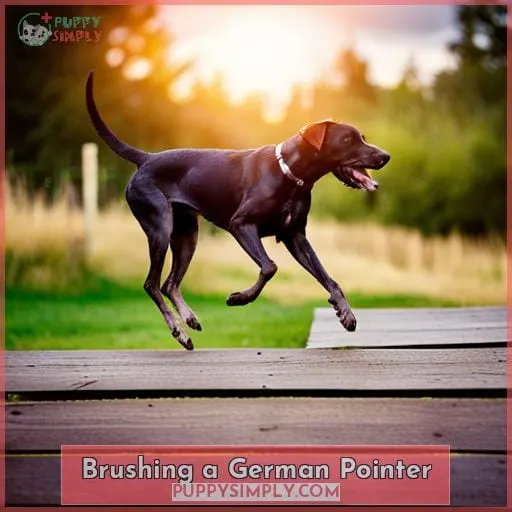This site is supported by our readers. We may earn a commission, at no cost to you, if you purchase through links.
 Pointers, with their athletic builds and acute hunting instincts, make for lively companions.
Pointers, with their athletic builds and acute hunting instincts, make for lively companions.
But you’re likely wondering if they shed, especially if you’re a neat freak.
Shedding is a natural process for dogs, and pointers are no exception.
In this article, we’ll delve into the shedding patterns of pointers, uncover the reasons behind excessive shedding, and provide practical tips to manage it effectively.
We’ll also explore the importance of grooming and diet in maintaining a healthy coat.
So, whether you’re a seasoned pointer owner or considering bringing one into your life, this comprehensive guide will help you navigate the world of pointer shedding.
Table Of Contents
- Key Takeaways
- Do Pointers Shed?
- Managing Pointer Shedding
- Appearance of German Pointers
- Coat of German Pointers
- Shedding Patterns in German Pointers
- Bathing a German Pointer
- Brushing a German Pointer
- Benefits of Grooming a Pointer
- Are Pointers Good Family Dogs?
- Health Issues to Watch for in Pointers
- Frequently Asked Questions (FAQs)
- Conclusion
Key Takeaways
- Pointer breeds shed mildly to moderately year-round with some seasonal fluctuations
- Regular brushing helps control shedding in all pointer breeds
- Providing good nutrition promotes a healthy coat and minimizes excessive shedding
- Regular grooming strengthens the human-canine bond and helps detect skin problems early
Do Pointers Shed?
Do pointers shed?
As gun dogs bred for endurance and athleticism in the field, most pointer breeds have short, sleek coats that require relatively minimal grooming and only shed a mild to moderate amount year-round.
Certain pointers like the German Longhaired Pointer blow their coats more heavily during spring and fall, but with routine brushing to control loose hairs, even profuse shedders can be simple to maintain in the home.
Regardless of coat type, implementing a regular brushing routine is key both for neatness and for the well-being of your pointer’s skin and coat health.
Pointer (English Pointer)
How much does your English Pointer shed?
As one of the lowest shedding and easiest to groom pointer breeds, the smooth, short-haired English Pointer only sheds a small amount of hair year-round.
This is manageable with weekly brushing using a bristle brush or rubber mitt.
To reduce shedding, ensure proper nutrition with omega-3s and a high-quality diet.
Check thyroid levels as well.
With simple weekly grooming techniques and seasonal care adjustments, keep your pointer’s coat healthy and shedding minimal.
German Shorthaired Pointer
By shedding year-round and seasonally, with heavier shedding in spring and fall, the German Shorthaired Pointer is a moderate shedding breed.
As working dogs bred for hunting, German Shorthaired Pointers have high exercise needs and benefit from training starting early to establish good manners.
Socialization is key to prevent issues with other dogs or small pets. They have strong prey drives that require management.
Their short, thick coats require minimal grooming, but regular brushing helps control shedding.
German Longhaired Pointer
You’ll find German Longhaired Pointers shed about the same as the Shorthaired Pointer year-round, but they blow their coat a couple of times per year.
When the seasonal shedding hits, be ready with frequent brushing sessions using a slicker brush and undercoat rake.
Bathe and blow out the coat before brushing to get the most hair out.
Stick to a schedule so you can stay on top of the increased shedding during coat blow.
Regular grooming prevents mats and keeps their beautiful coat in great condition.
German Wirehaired Pointer
With a wiry top coat and a thick undercoat, the German Wirehaired Pointer sheds a moderate amount throughout the year.
To keep shedding under control, groom them once or twice weekly with a slicker brush.
To manage their shedding:
- Brush thoroughly once or twice per week.
- Bathe only when necessary with a mild shampoo.
- Provide nutritious food to promote coat health.
- Give them plenty of exercise.
Regular grooming and care keep their coat healthy and contained.
Managing Pointer Shedding
You can take steps to manage your Pointer’s shedding:
- Focus on diet.
- Regular grooming.
- Checking thyroid hormone levels.
Addressing these key areas will help minimize excessive shedding in your Pointer.
Diet
Feeding your pointer a high-quality diet with omega-3s helps reduce shedding.
Talk to your vet about dietary recommendations or nutritional supplements to support healthy skin and coat.
Premium dog foods, homemade diets, or veterinarian-prescribed foods may be options.
Monitor how diet changes impact shedding over time and adjust as needed.
Finding the right food can significantly reduce excessive shedding.
Grooming
You can reduce a Pointer’s shedding by brushing him regularly with a firm bristle brush.
Regular grooming helps move natural oils through the coat and prevents tangling.
Here are 3 grooming tips:
- Bathe as needed using a hypoallergenic shampoo.
- Brush once a week with a bristle brush.
- Check for skin irritation or hot spots.
Regular grooming keeps the Pointer healthy and clean while reducing shedding around the home.
It also promotes bonding between pet and owner.
Thyroid
Your vet should test your pointer’s thyroid levels if shedding seems excessive, as hypothyroidism could be the culprit.
Thyroid issues often lead to increased shedding, so checking hormone levels through a simple blood test is wise.
If your dog is hypothyroid, daily thyroid medication and regular monitoring of levels is essential for proper dosage and effectiveness.
With consistent thyroid management and nutritional strategies that support coat health, you can get excessive shedding under control.
Regular grooming and providing good environmental conditions will also help minimize shedding while keeping your pointer happy and healthy.
Maintaining ideal thyroid function is key to managing seasonal and stress-related shedding patterns in this energetic breed.
Appearance of German Pointers
Having covered managing Pointer shedding, let’s turn to the appearance of German Pointers.
You’ll find these versatile gun dogs have a lean yet muscular build allowing them to run and swim with ease.
Take note of these key physical traits:
- Broad, long heads with ample room for their keen sense of smell
- Long, droopy ears that frame alert, intelligent eyes
- A docked, lively tail carried high as they eagerly scent and point
- Webbed feet that aid swimming and working in rough terrain
Their short, sleek liver coats showcase the German Pointer’s athleticism and allow the breed to fearlessly pursue game through brambles without tangling.
Regular brushing keeps their fur and skin healthy.
Coat of German Pointers
Examining a German Pointer’s coat, you’ll find a short, thick, sleek liver-colored fur that sheds mostly in spring and fall. Their naturally oily coat helps repel dirt and debris. Proper grooming keeps their coat healthy and minimizes shedding.
| Coat Length | Shedding Amount | Grooming Tips |
|---|
A German Pointer’s coat requires regular brushing and occasional bathing to minimize shedding. Their short to medium length coat sheds moderately, especially during seasonal changes. Establishing a proper grooming routine enhances coat health, reduces loose hairs around the home, and strengthens your bond.
Shedding Patterns in German Pointers
Your Pointer sheds mostly in spring and fall when losing their thick winter coat.
As the seasons change, you’ll notice more hair around your home that requires additional cleaning.
To help manage seasonal shedding:
- Brush frequently using a slicker brush.
- Bathe monthly using a moisturizing shampoo.
- Provide nutritional supplements.
- Use deshedding tools to remove loose hair.
Environmental factors like temperature changes prompt heavier shedding periods.
Staying on top of grooming and nutrition helps reduce excessive shedding year-round.
Implementing good coat maintenance techniques now makes managing seasonal blowing coat easier for you and your German Pointer.
Bathing a German Pointer
When bathing your Pointer, use a hypoallergenic dog shampoo if they have sensitive skin or allergies.
Don’t bathe too frequently to avoid drying out the skin and coat.
German Pointers have naturally water-resistant coats that help repel dirt and debris.
Use a moisturizing shampoo formulated specifically for dogs to clean the coat while preserving the skin’s natural oils.
Bathe every 2-3 months or when visibly dirty.
Routine bathing removes loose hairs and promotes new coat growth, reducing shedding.
Always thoroughly rinse to prevent residue buildup.
Be gentle when bathing sensitive areas.
Reward good behavior with treats and affection.
Proper coat care through occasional bathing improves skin health and reduces excessive shedding in German Pointers, contributing to less hair around the home.
Brushing a German Pointer
You’ll want to use a firm bristle brush or metal toothed comb to brush your German Pointer once a week.
This helps lift dead hair from the coat before it sheds all over your home.
Choose a brush that’s gentle but reaches down to the skin to remove loose fur.
Brush in the direction of hair growth using long strokes.
Start at the head and work back toward the hindquarters.
Go slowly and keep sessions positive, offering praise and treats.
Increase brushing during shedding seasons in spring and fall when they blow their coats.
Stick to a routine for stress-free grooming.
Regular brushing reduces loose hair in the environment while stimulating the skin for a healthy coat.
It also minimizes matting and allows you to bond with your pointer.
Benefits of Grooming a Pointer
Regularly grooming your pointer provides numerous benefits beyond reducing shedding.
Brushing helps distribute natural oils for healthy skin.
Bonding time strengthens your relationship.
Most importantly, proper grooming keeps your dog happy and comfortable in his own fur.
Reduce Shedding
Regularly grooming your pointer can help reduce shedding by promoting healthy skin and bonding with your dog.
Brushing distributes natural oils through the coat for skin health.
Regular grooming sessions are an opportunity to examine your dog’s body condition while removing loose hairs.
Supplementing omega-3s and ensuring adequate thyroid function support skin and coat health.
With a nutritious diet and proper grooming, you can manage your pointer’s shedding.
– Promote Skin Health
By grooming your Pointer regularly, you’re stimulating their skin and distributing natural oils that keep it healthy.
This helps prevent dryness that can lead to irritation and infections.
Ensure to brush thoroughly with a firm bristle brush, hand-stripping tool, or rubber mitt to lift dead hairs and distribute skin oils.
Use a hypoallergenic shampoo when bathing.
Monitor for skin issues like irritation or hot spots, which may indicate food allergies, thyroid problems, or other underlying issues causing inflammation.
Healthy skin means a happy, comfortable dog.
– Bond with Your Dog
Your relationship with your dog deepens through routine grooming sessions.
Brushing and bathing become bonding activities, with playtime ideas like giving treats or playing interactive games during grooming.
These training tips teach your pointer patience while handling and brushing, addressing any behavioral challenges.
Overall, shed management through regular grooming strengthens your relationship.
Are Pointers Good Family Dogs?
Pointers make wonderful family companions when provided with adequate exercise and training.
As high-energy dogs bred for hunting, pointers need plenty of activity to channel their energy properly. Commit to providing at least an hour of vigorous exercise like running or hiking daily.
Focus on obedience training early on to instill good manners, and continue reinforcing training throughout their life.
Proper socialization to people, animals, and environments from a young age is also key for a well-adjusted pointer.
With appropriate outlets for their energy, pointers form close bonds and can thrive in families.
Their short coats require minimal grooming. Shedding is moderate with weekly brushing.
Overall, pointers’ affectionate and even-tempered natures allow them to excel as family dogs given proper care.
Health Issues to Watch for in Pointers
Certain health issues you’re likely to encounter with Pointers include:
- Hip dysplasia
- Elbow dysplasia
- Hypothyroidism
- Canine epilepsy
- Eye issues (cataracts, glaucoma, progressive retinal atrophy)
- Allergies (food or environmental factors)
Hip and elbow dysplasia can cause lameness and arthritis. Keep your dog at a healthy weight and limit excessive exercise while bones are still growing.
Hypothyroidism leads to hair loss and weight gain. Have your vet check thyroid levels annually.
Epilepsy causes seizures. Work closely with your vet to control them through medication and lifestyle changes.
Eye issues may occur. Schedule regular eye exams.
Allergies to food or environmental factors can cause skin irritation and infections.
With attentive care and early diagnosis, many of these health issues can be well-managed. Maintain vet visits, provide proper nutrition, ensure adequate exercise, and monitor your pointer for any developing problems.
Frequently Asked Questions (FAQs)
How often should I bathe my pointer?
Bathe your pointer as needed, when dirty from outdoor play.
Use a hypoallergenic dog shampoo if your pointer has sensitive skin or allergies.
Brush your pointer once weekly with a firm bristle brush to distribute natural oils and prevent tangles.
Excessive bathing can dry the skin.
What types of brushes work best for pointers?
You’ll want to use a metal comb or firm bristle brush.
These allow you to penetrate your pointer’s short, thick coat and remove loose hairs before they can spread around your home.
Be gentle though – brushing should never irritate your dog’s skin.
Do some colors or coat types of pointers shed more than others?
You’re right to ask.
Coat color doesn’t impact shedding amount in pointers.
Their grooming needs relate more to coat length and thickness.
Regular brushing with an appropriate brush keeps shedding manageable across color variations.
Focus instead on proper nutrition and thyroid health.
That supports healthy skin and coats.
What changes in shedding should I expect as my pointer ages?
As your pointer ages, expect moderate shedding year-round.
Their coat will thin gradually, shedding less during cold months.
Regular brushing removes loose hairs before they fall.
Bathing less often prevents drying skin.
Quality diet and supplements support skin health for less shedding.
Are pointers compatible with homes that have severe allergies?
Unfortunately, pointers may not be the best breed for homes with severe allergies.
Their shedding, while mild, can still trigger reactions.
Checking with your allergist before getting a dog is wise.
There are some pointers with less shedding that may work, but reactions vary from person to person.
Focusing on breeds considered hypoallergenic is safer.
Conclusion
Investigating the facts shows pointers do shed, some more than others.
By providing proper nutrition, routine brushing, and monitoring thyroid health, you can manage excessive shedding and promote skin health.
Regular grooming also strengthens your bond.
Approach shedding as a natural occurrence, not a nuisance.
With attentive care and affection, your pointer will be a happy, loyal companion for years to come.















